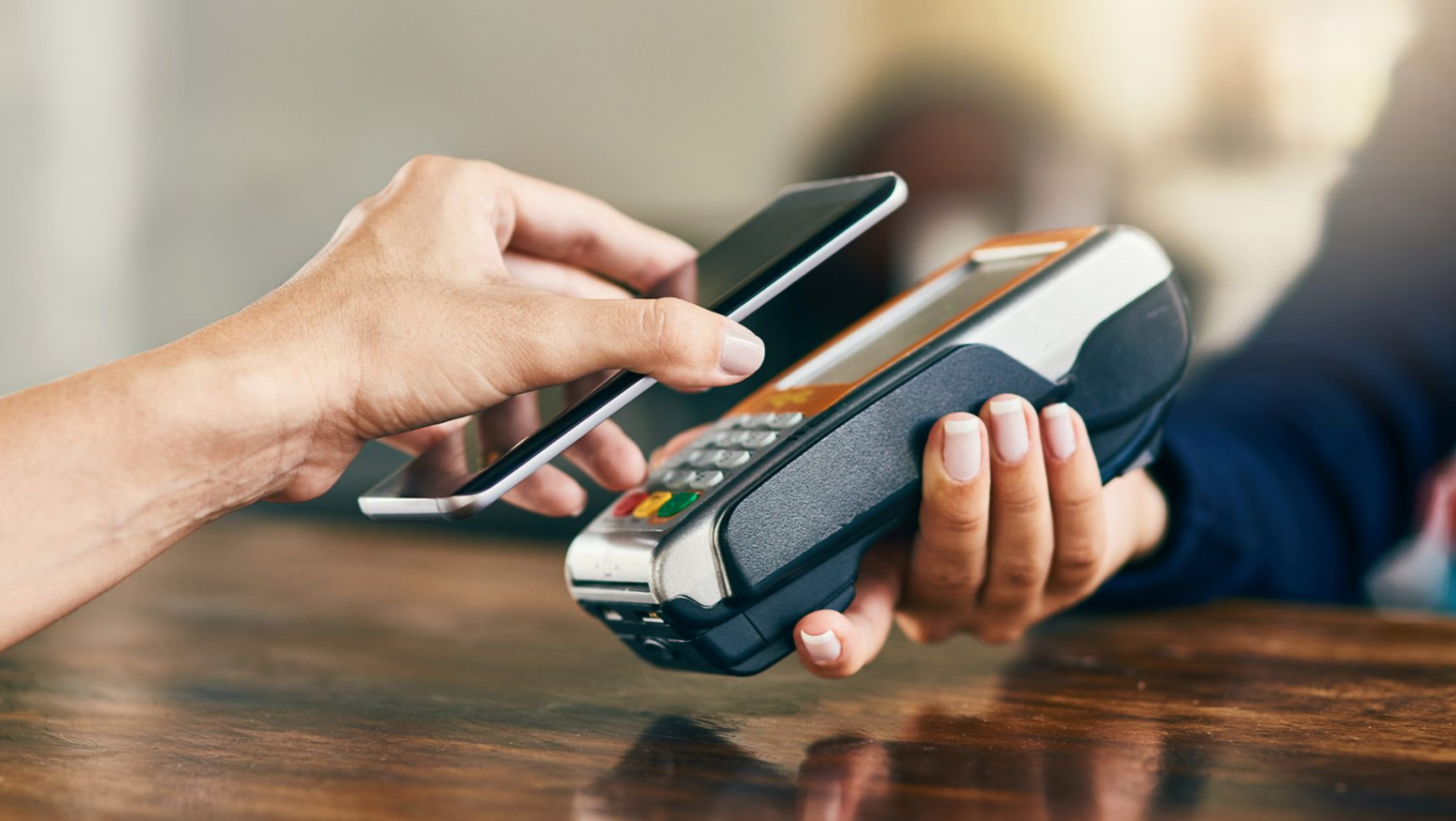Adoption of contactless payment has been slow, but the worldwide pandemic is providing additional motivation for it to become standard.
Anticipation is sweet, but instant gratification is tastier. Anyone who has used contactless payment knows this, because tech streamlines your time at the till. You simply wave your cell phone, wearable (smart watch, exercise tracker), or even the card itself in front of an enabled point-of-sale (POS) system. Bing! Your hazelnut latte craving is instantly gratified.
Better yet, if you use your wearable or mobile device, you won’t have to touch a germy terminal. According to the World Health Organization, “Hands touch many surfaces and can pick up viruses. Once contaminated, hands can transfer the virus to your eyes, nose, or mouth.” In the midst of the COVID-19 pandemic, contactless payment is a potentially life-saving technology.
Here’s how it works: After entering your credit card details to your digital wallet app—such as Apple Pay, Google Pay, Samsung Pay, Fitbit Pay, WeChat Pay, and Alipay—you hold your device near a POS terminal. The terminal uses near-field communication (NFC), a short-range implementation of RFID, to read the details of your wallet. Because NFC works only at a distance of less than 4 inches (10 centimeters), you can’t accidentally pay for the cappuccino of the guy at the next register.
Importantly, your credit card is shielded from the transaction. Take Apple Pay. Apple has your credit card on file and once you make a payment, Apple presents a one-time payment token to the device that processes the payment. That digital token represents the funds sent from you to the merchant, and when the digital settlement happens, the funds are billed to your credit card without the vendor ever seeing it. Thanks to this proxying, a Black Hat can’t intercept your flat white … along with your data.
Despite all of this fabulousness, the U.S. is lagging in contactless payment.
Omer Cheema, director of strategy at Samsung, says, “More than 50 percent of the transactions in Europe are being done contactlessly as compared to less than 20 percent in the U.S.”
So what will we see in the future of a service that, at least in the U.S., still feels futuristic? We should expect the following.
Contactless payment will overtake cash
Germaphobes have eschewed cash for years, ever since learning about the “diverse microbial population” (egads) found on currency. Now, coronavirus has made us even more aware of the phrase “bad touching.”
Since COVID-19 turned up, 27 percent of small businesses have seen an increase in contactless payment over cash. Germany, a European Union country that has historically favored cash over credit, is becoming euro-skeptic: Contactless payments in pre-pandemic Germany leveled off at 35 percent of transactions. Here in 2020, that number has grown to 50 percent. Those numbers will climb like they’ve got a pair of crampons.
Yes, processing fees are a bummer, for both the merchant, which has to mark up its goods to pay for them, and the customer, who ultimately shells out. The paranoid among us prefer processing fees over microbes.
Contactless payment will overtake traditional credit card payments
Maksym Babych, CEO at SpdLoad, a software development company whose area of expertise is the implementation of payment solutions, predicts that “in three years, contactless payment will overtake traditional card payments.” Here’s why: Most countries have a ceiling on the amount of money you can contactlessly spend at once, and if you exceed that amount, you’re required to tap out your PIN code.
Since no one wants to touch a keypad more than they have to, 48 countries have increased spending limits on contactless payments. For example, the U.K.’s spending limit went from £30 (US$36.60) to £45 (US$54.90), while Canada’s leapt from CAD$100 (US$71.50) to CAD$250 (US$179.20).
While contactless payment is considered as secure as chip and PIN, Chris Ibbitson, chief technologist for banking at Hewlett Packard Enterprise, says using a contactless payment system like Apple Pay or Samsung Pay on a mobile device versus a card and PIN is “much more secure” than that. Ibbitson says, “You have to physically have the device, [and] you have to be able to unlock it.” This means you need to input your device’s password (as in the case of Fitbit Pay) or use its biometric data like facial recognition or a fingerprint (as in the case of current smartphones), which is even stronger than just needing the password or PIN.
Traditional credit card payments simply require you to have possession of the credit card. But using one of the secure wallet technologies, such as Apple Pay, with a smartphone adds additional layers of security to the user side of the payment process. This type of contactless payment follows the basic requirements of multifactor authentication by having you present more than one way to prove you are you: using something you have, something you know, and something you are. There is now a stronger certainty that the person paying is the person associated with the device (and hopefully, the credit card tied to that device). Remember that using the card-only contactless payment method does address the concerns of physically touching devices but does not guarantee that the person holding the card is an authorized user.
According to Visa, this innate security means that global fraud rates of contactless payment is “one-tenth of 1 percent.”
It will be more widely adopted in the U.S.
Consumers outside of major cities just aren’t that familiar with the process of paying for their items contactlessly. Not only that, there’s the cost of buying POS terminals that accept contactless payment. But it seems the biggest reason U.S. retailers have been slow to adopt contactless payment is they’re just not required to.
Brad Fick, president of Direct Source, a retail payment and technology systems integration business, says, “There are two regulatory bodies that tend to drive faster payment technology adoption: the National Retail Federation, which is the lobbying arm for retailers, and the Payment Card Industry (PCI) Security Standards Council, which was formed by the credit card companies themselves. For example, if retailers choose not to adopt payment standards and technology that Mastercard and Visa ask them to adopt, the retailer can be liable for any fraudulent transactions. This pressure drives change faster than simply allowing organic technology adoption.”
PCI is working to make contactless payment more accessible. Fick says, “In late 2019, the Security Standards Council issued a new PCI Contactless Payments on COTS [CPoC™] standard and supporting validation program. This means that retail technology vendors can provide merchants with contactless solutions that have been developed and lab tested to protect payment data, giving retailers more confidence to adopt solutions faster and with less risk.”
When regulatory bodies eventually make a push toward contactless payment, it will become more widely adopted. eMarketer estimates that by 2021, the transactional value of contactless payment will be $161.41 billion in the U.S. alone.
Its tipping flaw will be fixed
Tipping: Why can’t you add a contactless tip when you’re contactlessly paying for coffee? It’s a problem mostly confined to the tip-heavy U.S., but it’s a problem nevertheless.
If you want to show appreciation for your barista’s fabulous latte art, you need to 1) wait for the cashier to swing a touchpad toward you, 2) select a tip amount from the presented options, 3) sign for it, and 4) have the cashier accept your tip. Only then can you enjoy your beverage. Not only is this inelegant compared with just waving your smartphone theatrically, every customer is touching the same device in the same place.
But this flaw could be fixed contactlessly if you’re using a smart device with a screen. You’ll likely have to use your phone or exercise tracker to tip (unless, in the future, we can tip via voice command). But at least you’ll be touching your own screen, rather than a screen touched by dozens of others.
Bitcoin and cryptocurrency become mainstream
Cryptocurrency may be the best way to transfer funds anonymously, but it is not great to buy a croissant for my other coffee-based examples. Many merchants who had been early adopters stopped accepting cryptocurrency because of “price volatility and slow processing times,” as no one wants to wait to see if they do or do not own a donut.
But if you have cryptocurrency, you likely have a cryptocurrency wallet on your phone, which means all the ingredients for the use of crypto in daily life are at your fingertips (or your recognized face).
“Because digital payments have become a norm, contactless payment adoption is increasing,” Cheema says, “Consumers have access to their banking, stocks, bills, and retail stores on their phones, and this will probably pave way for cryptocurrency adoption in the long term.”
Cheema says fintech solutions will be emerging.
Why you wouldn’t want to go contactless
Contactless payment is a fabulous way for time-strapped people to pay for their goods and go. However, it’s not for the cash-strapped: NFC-enabled credit cards aside, you first have to afford a smartphone or wearable, and then pair it with a credit card or bank account. As only seven out of 10 Americans have a credit card and 6.5 percent (8.4 million) of U.S. households have no bank account at all, contactless payment is great only for those who can afford it.
Not only that, privacy advocates will want you to think twice about forgoing cash, as the term contactless payment means traceable credit card or bank charge. Also, as a former poor person, I say from experience that using cash over a credit card helps you rein in thoughtless spending and stick to your budget.
Plus, the flaws that contactless payments can fix—by increasing security and allowing you to include tips in payments—can help you only if you’re using a wearable or a smartphone. These don’t apply when you’re simply tapping your screenless, non-interactive card at a POS terminal.
And why you should
I was actually a naysayer when it came to contactless payment, as I didn’t like the idea of broadcasting my status as an “elite” Apple user. But when I tried it at my grocery store, my transaction was effortless. So are my trips on the New York subway and in taxis.
By allowing me to pay for my goods quickly, without feeling the stares of impatient shoppers as I rifled through my purse, contactless payment removed a pain point I never knew I had.
Contactless payment may work like tech, but after paying for my items with a wave of my hand, it feels like magic.

